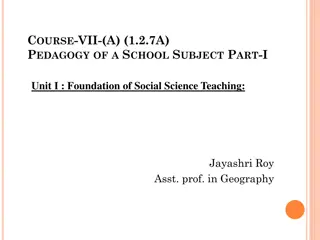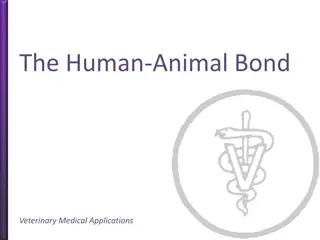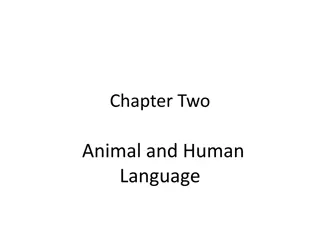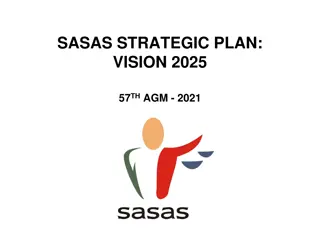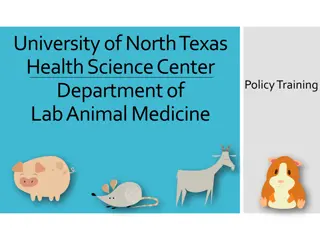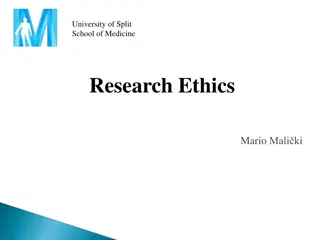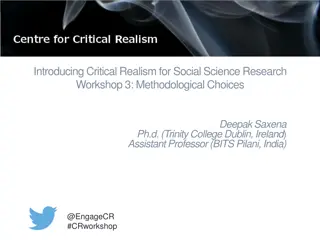Exploring Human-Animal Relationships Through Social Science Research: A 25-Year Review
Delve into the intricate world of human-animal interactions with a comprehensive examination of 25 years of social science research. Discover thought-provoking studies that explore the symbolic, cultural, and emotional dynamics shaping our relationships with animals. From the moral universes of cockfighters to the symbolic roles of animals in indigenous rituals, this research offers profound insights into the complex and multifaceted connections between society and animals.
- Human-animal relationships
- Social science research
- Animal symbolism
- Cultural dynamics
- Ethical perspectives
Download Presentation

Please find below an Image/Link to download the presentation.
The content on the website is provided AS IS for your information and personal use only. It may not be sold, licensed, or shared on other websites without obtaining consent from the author. Download presentation by click this link. If you encounter any issues during the download, it is possible that the publisher has removed the file from their server.
E N D
Presentation Transcript
Society & Animals: 25 Years of Social Science Research Margo DeMello Human-Animal Studies Program Director
Sociology and Anthropology Qualitative and Quantitative Since 1993, 464 articles published, not counting reviews or announcements Approximately 126 are sociological or anthropological in either method or scope (broadly defined)
A Selection of Articles By Year and Popularity ! Among 50 most downloaded S&A articles *Among 100 most cited S&A articles
1990s *Russell, C. L. (1995). The social construction of orangutans: An ecotourist experience. Society & Animals, 3(2), 151- 170. Lawrence, E. A. (1993). The symbolic role of animals in the Plains Indian sun dance. Society & Animals, 1(1), 17-37. Hawley, F. (1993). The moral and conceptual universe of cockfighters: Symbolism and rationalization. Society & Animals, 1(2), 159-168. * Dahles, H. (1993). Game killing and killing games: An anthropologist looking at hunting in a modern society. Society & Animals, 1(2), 169-184. Noske, B. (1993). The animal question in anthropology: A commentary. Society and Animals, 1(2), 185-190. * Nibert, D. A. (1994). Animal rights and human social issues. Society & Animals, 2(2), 115-124. Laurent, E. (1995). Definition and cultural representation of the category mushi in Japanese culture. Society & Animals, 3(1), 61-77. * Holbrook, M. B. (1996). Reflections on rocky. Society & Animals, 4(2), 147-168. * Alger, J. M., & Alger, S. F. (1997). Beyond Mead: Symbolic interaction between humans and felines. Society & Animals, 5(1), 65-81. Miles, W. F. (1997). Pigs, politics and social change in Vanuatu. Society & Animals, 5(2), 155-167. * Forsyth, C. J., & Evans, R. D. (1998). Dogmen: The rationalization of deviance. Society & Animals, 6(3), 203-218. Frommer, S. S., & Arluke, A. (1999). Loving them to death: Blame-displacing strategies of animal shelter workers and surrenderers. Society & Animals, 7(1), 1-16. * Alger, J. M., & Alger, S. F. (1999). Cat culture, human culture: An ethnographic study of a cat shelter. Society & Animals, 7(3), 199-218
2000s * Twining, H., Arluke, A., & Patronek, G. (2000). Managing the stigma of outlaw breeds: A case study of pit bull owners. Society & Animals, 8(1), 25-52. Flynn, C. P. (2000). Battered women and their animal companions: Symbolic interaction between human and nonhuman animals. Society & Animals, 8(2), 99-127. Munro, L. (2001). Caring about blood, flesh, and pain: Women's standing in the animal protection movement. Society & Animals, 9(1), 43-61. * Flynn, C. P. (2001). Acknowledging the" Zoological connection": A sociological analysis of animal cruelty. Society & Animals, 9(1), 71-87. * Stibbe, A. (2001). Language, power and the social construction of animals. Society & Animals, 9(2), 145-161. * Drews, C. (2001). Wild animals and other pets kept in Costa Rican households: incidence, species and numbers. Society & Animals, 9(2), 107-126. Marvin, G. (2001). Cultured killers: Creating and representing foxhounds. Society & Animals, 9(3), 273-292. Irvine, L. (2002). Animal problems/people skills: Emotional and interactional strategies in humane education. Society & Animals, 10(1), 63-91. * Lowe, B. M., & Ginsberg, C. F. (2002). Animal rights as a post-citizenship movement. Society & Animals, 10(2), 203- 215. Cassidy, R. (2002). The social practice of racehorse breeding. Society & Animals, 10(2), 155-171. * Griffith, M., Wolch, J., & Lassiter, U. (2002). Animal practices and the racialization of Filipinas in Los Angeles. Society & Animals, 10(3), 221-248.
2000s * Beirne, P. (2002). Criminology and animal studies: A sociological view. Society & Animals, 10(4), 381-386. Jerolmack, C. (2003). Tracing the profile of animal rights supporters: A preliminary investigation. Society & Animals, 11(3), 245-263. * Anderson, P. K. (2003). A bird in the house: An anthropological perspective on companion parrots. Society & Animals, 11(4), 393-418. * Stibbe, A. (2003). As charming as a pig: The discursive construction of the relationship between pigs and humans. Society & Animals, 11(4), 375-392. * Greenebaum, J. (2004). It's a dog's life: Elevating status from pet to" fur baby" at yappy hour. Society & Animals, 12(2), 117-135. * Brandt, K. (2004). A language of their own: An interactionist approach to human-horse communication. Society & Animals, 12(4), 299-316. Kalof, L., Fitzgerald, A., & Baralt, L. (2004). Animals, women, and weapons: Blurred sexual boundaries in the discourse of sport hunting. Society & Animals, 12(3), 237-251. Brown, S. E. (2005). The under-representation of African American employees in animal welfare organizations in the United States. Society & Animals, 13(2), 153-162. Novek, J. (2005). Pigs and people: Sociological perspectives on the discipline of nonhuman animals in intensive confinement. Society & Animals, 13(3), 221-244. * Birke, L. (2007). Learning to speak horse": The culture of" Natural Horsemanship. Society & Animals, 15(3), 217- 239. !* Wood, L. J., Giles-Corti, B., Bulsara, M. K., & Bosch, D. A. (2007). More than a furry companion: The ripple effect of companion animals on neighborhood interactions and sense of community. Society & Animals, 15(1), 43-56. * Holmberg, T. (2008). A feeling for the animal: On becoming an experimentalist. Society & Animals, 16(4), 316-335.
2000s * Potts, A. (2009). Kiwis against possums: A critical analysis of anti-possum rhetoric in Aotearoa New Zealand. Society & Animals, 17(1), 1-20. !* Mullin, M. (2002). Animals and anthropology. Society and Animals, 10(4), 387-394. !* Serpell, J. A. (2002). Anthropomorphism and Anthropomorphic Selection Beyond the" Cute Response". Society & Animals, 10(4), 437-454. * Russell, N. (2002). The wild side of animal domestication. Society & Animals, 10(3), 285-302. Hurn, S. (2008). What's Love Got To Do With It? The Interplay of Sex and Gender in The Commercial Breeding of Welsh Cobs. Society & Animals, 16(1), 23-44. Greenebaum, J. (2009). " I'm Not an Activist!": Animal Rights vs. Animal Welfare in the Purebred Dog Rescue Movement. Society & Animals, 17(4), 289-304. Markovits, A. S., & Queen, R. (2009). Women and the world of dog rescue: A case study of the state of Michigan. Society & Animals, 17(4), 325-342. * Arluke, A. (2002). A sociology of sociological animal studies. Society and Animals, 10(4), 369-374. ! Kruse, C. R. (2002). Social animals: Animal studies and sociology. Society and Animals, 10(4), 375-380. Beirne, P. (2002). Criminology and animal studies: A sociological view. Society & Animals, 10(4), 381-386.
2010s (so far) ! Ellis, C., & Irvine, L. (2010). Reproducing dominion: Emotional apprenticeship in the 4-H youth livestock program. Society & Animals, 18(1), 21-39. Kuhl, G. (2011). Human-sled dog relations: What can we learn from the stories and experiences of mushers?. Society & Animals, 19(1), 22-37. Vermilya, J. R. (2012). Contesting horses: Borders and shifting social meanings in veterinary medical education. Society & Animals, 20(2), 123-137. ! Porcher, J., & Schmitt, T. (2012). Dairy cows: workers in the shadows? Society & Animals, 20(1), 39-60. ! Nimmo, R. (2012). Animal Cultures, Subjectivity, and Knowledge: Symmetrical Reflections beyond the Great Divide. Society & Animals, 20(2), 173-192. Jackson, P. (2012). Situated activities in a dog park: identity and conflict in human-animal space. Society & Animals, 20(3), 254-272. Young, R. L. (2013). Regarding Rocky: A theoretical and ethnographic exploration of interspecies intersubjectivity. Society & Animals, 21(3), 294-313. White, K. (2013). And say the cat responded? Getting closer to the feline gaze. Society & animals, 21(1), 93-104. deKoninck, V. (2014). Encounters on the frontier: Banteng in Australia's Northern Territory. Society & Animals, 22(1), 26-41. Coulter, K. (2014). Herds and hierarchies: Class, nature, and the social construction of horses in equestrian culture. Society & Animals, 22(2), 135-152.
2010s (so far) ! Jacques, J. R. (2015). The Slaughterhouse, Social Disorganization, and Violent Crime in Rural Communities. society & animals, 23(6), 594-612. Birke, L., & Hockenhull, J. (2015). Journeys together: Horses and humans in partnership. Society & Animals, 23(1), 81-100. Coulter, K. (2014). Herds and hierarchies: Class, nature, and the social construction of horses in equestrian culture. Society & Animals, 22(2), 135-152. ! Krebber, A. (2015). Claiming Rights for Non-Human Animals: Civilization s Ultimate Challenge. Society & Animals, 23(1), 101-104. Wlodarczyk, J. (2016). Post-Communist Canine: A Feminist Approach to Women and Dogs in Canine Performance Sports in Poland. society & animals, 24(2), 129-152. Palmer, A., Malone, N., & Park, J. (2016). Caregiver/Orangutan Relationships at Auckland Zoo. Society & Animals, 24(3), 230-249. Garcia, A. C. (2016). The Place of the Dog in the Family. Society & Animals, 24 (3), 289-309 Stoddart, M. C., Swiss, L., Power, N., & Felt, L. F. (2016). Taking Care of Companion Animals. Society & Animals, 24 (5): 423 444 Edwards, F., & Dixon, J. (2016). Hum of the Hive. Society & Animals, 24(6), 535-555.
The Winners !* Wood, L. J., Giles-Corti, B., Bulsara, M. K., & Bosch, D. A. (2007). More than a furry companion: The ripple effect of companion animals on neighborhood interactions and sense of community. Society & Animals, 15(1), 43-56. !* Mullin, M. (2002). Animals and anthropology. Society and Animals, 10(4), 387-394. !* Serpell, J. A. (2002). Anthropomorphism and Anthropomorphic Selection Beyond the" Cute Response". Society & Animals, 10(4), 437-454. * Stibbe, A. (2003). As charming as a pig: The discursive construction of the relationship between pigs and humans. Society & Animals, 11(4), 375-392. * Greenebaum, J. (2004). It's a dog's life: Elevating status from pet to" fur baby" at yappy hour. Society & Animals, 12(2), 117- 135. * Brandt, K. (2004). A language of their own: An interactionist approach to human-horse communication. Society & Animals, 12(4), 299-316. * Birke, L. (2007). Learning to speak horse": The culture of" Natural Horsemanship. Society & Animals, 15(3), 217-239. * Nibert, D. A. (1994). Animal rights and human social issues. Society & Animals, 2(2), 115-124. * Russell, C. L. (1995). The social construction of orangutans: An ecotourist experience. Society & Animals, 3(2), 151-170. * Alger, J. M., & Alger, S. F. (1997). Beyond Mead: Symbolic interaction between humans and felines. Society & Animals, 5(1), 65- 81. ! Krebber, A. (2015). Claiming Rights for Non-Human Animals: Civilization s Ultimate Challenge. Society & Animals, 23(1), 101- 104. ! Ellis, C., & Irvine, L. (2010). Reproducing dominion: Emotional apprenticeship in the 4-H youth livestock program. Society & Animals, 18(1), 21-39. Vermilya, J. R. (2012). Contesting horses: Borders and shifting social meanings in veterinary medical education. Society & Animals, 20(2), 123-137. ! Porcher, J., & Schmitt, T. (2012). Dairy cows: workers in the shadows? Society & Animals, 20(1), 39-60. ! Nimmo, R. (2012). Animal Cultures, Subjectivity, and Knowledge: Symmetrical Reflections beyond the Great Divide 1. Society & Animals, 20(2), 173-192. ! Jacques, J. R. (2015). The Slaughterhouse, Social Disorganization, and Violent Crime in Rural Communities. society & animals, 23(6), 594-612.
Image result for anthropomorphism cute response And the winner is Serpell, J. A. (2002). Anthropomorphism and Anthropomorphic Selection Beyond the" Cute Response." Society & Animals, 10(4), 437-454. Cited 248 times
Some Thoughts Older articles cited more frequently than newer ones More recent articles downloaded more frequently than older articles Established HAS scholars don t always get big hits; most citations (Serpell, Stibbe, Brown, Brandt, Alger, Kruse, Russell, Greenebaum, Birke, Nibert) are a mix of well-known and less well known. Same for most downloads; top articles (Nimmo, Mullin, Porcher, Serpell, Ellis, Kruse, Jacques, Woodward, Krebber) are also a mix of established and newer scholars. 2000s had the greatest number of anthro/soc articles; numbers seem to be going down in recent decade Not much with respect to policy implications A number of articles used in HAS courses--especially sociology Low numbers overall!
A Note on Citations Why so few citations overall? Partly, it's the field itself. Anthrozo s most cited article, Nimer, J., & Lundahl, B. (2007). Animal-assisted therapy: A meta-analysis. Anthrozo s, 20(3), 225-238, was only cited 341 times. Partly, it's the type of paper that tends to be highly cited in academia: methods papers tend to be the most highly cited of scientific papers, as well as papers on software, and our field rarely produces those. And some scientists cite each other s work more often (biologists). According to Nature, the most highly cited article with over 300,000 citations is: Lowry, O. H., Rosebrough, N. J., Farr, A. L., & Randall, R. J. (1951). Protein measurement with the Folin phenol reagent. J biol Chem, 193(1), 265- 275.
Citations don't tell the whole story; many of these articles are commonly assigned as readings in HAS courses, particularly those taught in anthropology and sociology departments.
More Thoughts Ethnographic methods--especially interviews; participant observation less common; very little multi-species ethnography Relatively few non-US settings, but more in recent years Very few comparative articles Sociology dominant over anthropology People-pet (including horses) relationships are by far the most dominant; in the home, shelter, veterinary office, park, or other common location
Disciplinary Commentaries Mullin, M. (2002). Animals and anthropology. Society and Animals, 10(4), 387-394. Arluke, A. (2002). A sociology of sociological animal studies. Society and Animals, 10(4), 369-374. Kruse, C. R. (2002). Social animals: Animal studies and sociology. Society and Animals, 10(4), 375-380.
Animals as Symbols Lawrence, E. A. (1993). The symbolic role of animals in the Plains Indian sun dance. Society & Animals, 1(1), 17-37. Hawley, F. (1993). The moral and conceptual universe of cockfighters: Symbolism and rationalization. Society & Animals, 1(2), 159-168. Miles, W. F. (1997). Pigs, politics and social change in Vanuatu. Society & Animals, 5(2), 155-167.
Deviance and Crime Forsyth, C. J., & Evans, R. D. (1998). Dogmen: The rationalization of deviance. Society & Animals, 6(3), 203- 218. Beirne, P. (2002). Criminology and animal studies: A sociological view. Society & Animals, 10(4), 381-386. Flynn, C. P. (2001). Acknowledging the" Zoological connection": A sociological analysis of animal cruelty. Society & Animals, 9(1), 71-87. Twining, H., Arluke, A., & Patronek, G. (2000). Managing the stigma of outlaw breeds: A case study of pit bull owners. Society & Animals, 8(1), 25-52. Flynn, C. P. (2000). Battered women and their animal companions: Symbolic interaction between human and nonhuman animals. Society & Animals, 8(2), 99-127. Jacques, J. R. (2015). The Slaughterhouse, Social Disorganization, and Violent Crime in Rural Communities. society & animals, 23 (6), 594-612.
Animals as Social Actors Alger, J. M., & Alger, S. F. (1997). Beyond Mead: Symbolic interaction between humans and felines. Society & Animals, 5(1), 65-81. Brandt, K. (2004). A language of their own: An interactionist approach to human-horse communication. Society & Animals, 12(4), 299-316. Young, R. L. (2013). Regarding Rocky: A theoretical and ethnographic exploration of interspecies intersubjectivity. Society & Animals, 21(3), 294-313.
People Who Work with Animals Frommer, S. S., & Arluke, A. (1999). Loving them to death: Blame-displacing strategies of animal shelter workers and surrenderers. Society & Animals, 7(1), 1-16. Alger, J. M., & Alger, S. F. (1999). Cat culture, human culture: An ethnographic study of a cat shelter. Society & Animals, 7(3), 199-218. Ellis, C., & Irvine, L. (2010). Reproducing dominion: Emotional apprenticeship in the 4-H youth livestock program. Society & Animals, 18(1), 21-39. Kuhl, G. (2011). Human-sled dog relations: What can we learn from the stories and experiences of mushers?. Society & Animals, 19(1), 22-37. Vermilya, J. R. (2012). Contesting horses: Borders and shifting social meanings in veterinary medical education. Society & Animals, 20(2), 123-137. Porcher, J., & Schmitt, T. (2012). Dairy cows: workers in the shadows? Society & Animals, 20(1), 39-60. Birke, L., & Hockenhull, J. (2015). Journeys together: Horses and humans in partnership. Society & Animals, 23(1), 81-100. Coulter, K. (2014). Herds and hierarchies: Class, nature, and the social construction of horses in equestrian culture. Society & Animals, 22(2), 135-152. Palmer, A., Malone, N., & Park, J. (2016). Caregiver/Orangutan Relationships at Auckland Zoo. Society & Animals, 24(3), 230-249.
The Animal Welfare/Rights Movements Jerolmack, C. (2003). Tracing the profile of animal rights supporters: A preliminary investigation. Society & Animals, 11(3), 245-263. Munro, L. (2001). Caring about blood, flesh, and pain: Women's standing in the animal protection movement. Society & Animals, 9(1), 43-61. Markovits, A. S., & Queen, R. (2009). Women and the world of dog rescue: A case study of the state of Michigan. Society & Animals, 17(4), 325-342 Brown, S. E. (2005). The under-representation of African American employees in animal welfare organizations in the United States. Society & Animals, 13(2), 153-162.
Social Construction of Animals Laurent, E. (1995). Definition and cultural representation of the category mushi in Japanese culture. Society & Animals, 3(1), 61-77. Russell, C. L. (1995). The social construction of orangutans: An ecotourist experience. Society & Animals, 3(2), 151-170. Stibbe, A. (2003). As charming as a pig: The discursive construction of the relationship between pigs and humans. Society & Animals, 11(4), 375-392. Potts, A. (2009). Kiwis against possums: A critical analysis of anti-possum rhetoric in Aotearoa New Zealand. Society & Animals, 17(1), 1-20. Stibbe, A. (2001). Language, power and the social construction of animals. Society & Animals, 9(2), 145- 161. Coulter, K. (2014). Herds and hierarchies: Class, nature, and the social construction of horses in equestrian culture. Society & Animals, 22(2), 135-152.
Speaking with, about, for, and to Animals Stibbe, A. (2003). As charming as a pig: The discursive construction of the relationship between pigs and humans. Society & Animals, 11(4), 375-392. Brandt, K. (2004). A language of their own: An interactionist approach to human-horse communication. Society & Animals, 12(4), 299-316. Birke, L. (2007). Learning to speak horse: The culture of Natural Horsemanship. Society & Animals, 15(3), 217-239. Stibbe, A. (2001). Language, power and the social construction of animals. Society & Animals, 9(2), 145-161.
Multi-Species Ethnography White, K. (2013). And say the cat responded? Getting closer to the feline gaze. Society & animals, 21(1), 93-104. Birke, L., & Hockenhull, J. (2015). Journeys together: Horses and humans in partnership. Society & Animals, 23(1), 81-100. Coulter, K. (2014). Herds and hierarchies: Class, nature, and the social construction of horses in equestrian culture. Society & Animals, 22(2), 135-152. Young, R. L. (2013). Regarding Rocky: A theoretical and ethnographic exploration of interspecies intersubjectivity. Society & Animals, 21(3), 294-313.
Future Directions: A Wish List More methods papers More multi-species ethnography, and with it, more focus on non-human interactants More entries from other cultures Less focus on pets, and more on other domesticated animals, and, ideally, wild animals
The Animals & Society Institute 2512 Carpenter Road, Suite 202-A Ann Arbor, MI 48108-1188 USA (734) 677-9240 www.animalsandsociety.org www.humananimalstudies.org For more information, contact: Margo DeMello Human-Animal Studies Program Director margo@animalsandsociety.org









